高级微观经济学 讲义5
- 格式:pdf
- 大小:176.41 KB
- 文档页数:6
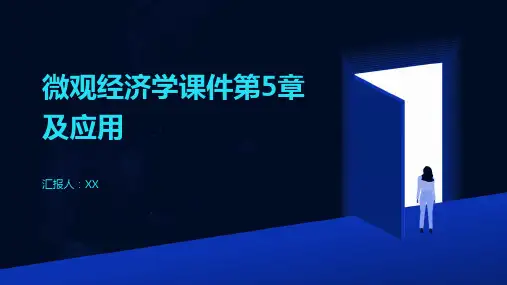
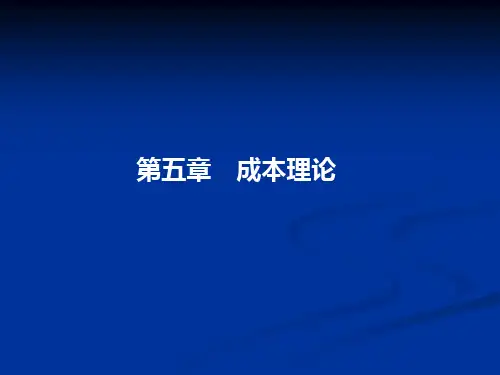
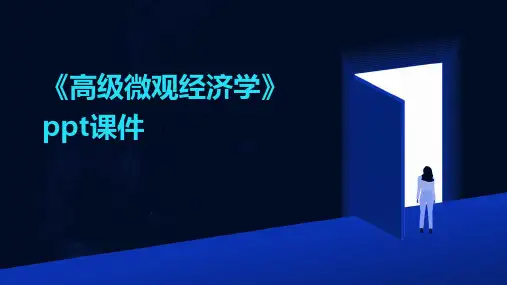
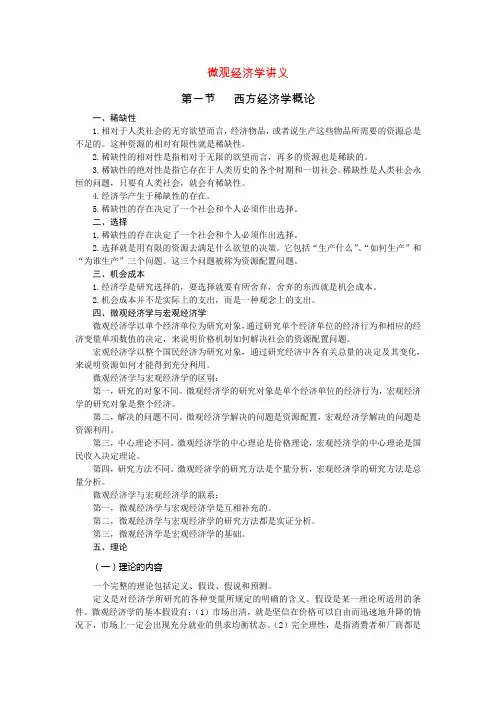
微观经济学讲义第一节西方经济学概论一、稀缺性1.相对于人类社会的无穷欲望而言,经济物品,或者说生产这些物品所需要的资源总是不足的。
这种资源的相对有限性就是稀缺性。
2.稀缺性的相对性是指相对于无限的欲望而言,再多的资源也是稀缺的。
3.稀缺性的绝对性是指它存在于人类历史的各个时期和一切社会。
稀缺性是人类社会永恒的问题,只要有人类社会,就会有稀缺性。
4.经济学产生于稀缺性的存在。
5.稀缺性的存在决定了一个社会和个人必须作出选择。
二、选择1.稀缺性的存在决定了一个社会和个人必须作出选择。
2.选择就是用有限的资源去满足什么欲望的决策。
它包括“生产什么”、“如何生产”和“为谁生产”三个问题。
这三个问题被称为资源配置问题。
三、机会成本1.经济学是研究选择的,要选择就要有所舍弃,舍弃的东西就是机会成本。
2.机会成本并不是实际上的支出,而是一种观念上的支出。
四、微观经济学与宏观经济学微观经济学以单个经济单位为研究对象,通过研究单个经济单位的经济行为和相应的经济变量单项数值的决定,来说明价格机制如何解决社会的资源配置问题。
宏观经济学以整个国民经济为研究对象,通过研究经济中各有关总量的决定及其变化,来说明资源如何才能得到充分利用。
微观经济学与宏观经济学的区别:第一,研究的对象不同。
微观经济学的研究对象是单个经济单位的经济行为,宏观经济学的研究对象是整个经济。
第二,解决的问题不同。
微观经济学解决的问题是资源配置,宏观经济学解决的问题是资源利用。
第三,中心理论不同。
微观经济学的中心理论是价格理论,宏观经济学的中心理论是国民收入决定理论。
第四,研究方法不同。
微观经济学的研究方法是个量分析,宏观经济学的研究方法是总量分析。
微观经济学与宏观经济学的联系:第一,微观经济学与宏观经济学是互相补充的。
第二,微观经济学与宏观经济学的研究方法都是实证分析。
第三,微观经济学是宏观经济学的基础。
五、理论(一)理论的内容一个完整的理论包括定义、假设、假说和预测。
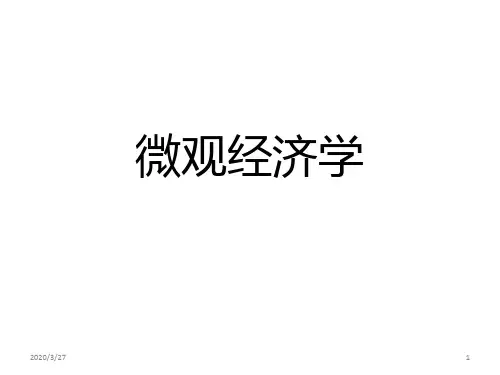
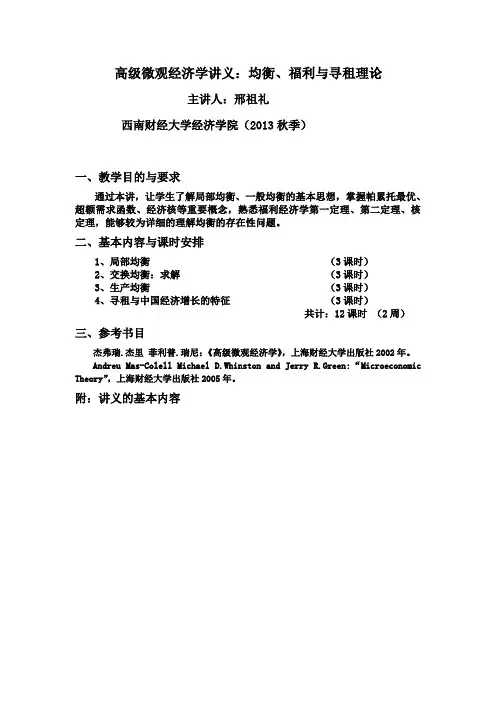
高级微观经济学讲义:均衡、福利与寻租理论主讲人:邢祖礼西南财经大学经济学院(2013秋季)一、教学目的与要求通过本讲,让学生了解局部均衡、一般均衡的基本思想,掌握帕累托最优、超额需求函数、经济核等重要概念,熟悉福利经济学第一定理、第二定理、核定理,能够较为详细的理解均衡的存在性问题。
二、基本内容与课时安排1、局部均衡(3课时)2、交换均衡:求解(3课时)3、生产均衡(3课时)4、寻租与中国经济增长的特征(3课时)共计:12课时(2周)三、参考书目杰弗瑞.杰里菲利普.瑞尼:《高级微观经济学》,上海财经大学出版社2002年。
Andreu Mas-Colell Michael D.Whinston and Jerry R.Green:“Microeconomic Theory”,上海财经大学出版社2005年。
附:讲义的基本内容高级微观经济学讲义:均衡、福利与寻租理论邢祖礼西南财经大学经济学院2013年秋季第一讲:局部均衡分析一、竞争性均衡1、拟线性效用函数Quasi-linear utility function:)(),(i i i i i i x m x m u ϕ+=, i x 是一个消费产品, i m 是其他所产品的支出。
这种函数形式暗含两个假设:(1) x 产品没有收入效应,即x 产品的边际效用独立于收入m ;(2) x 产品的价格不影响其他产品的价格。
通过这两个假设,我们可以得出:其他产品的价格独立于x 产品。
2、需求:)(max i i i x m ϕ+s.t. i i i m p x y +⋅≤ (*)从 (*)中, 我们有:i i i m y p x =-⋅代入目标函数有:max ()ii i i i x x p x y φ-⋅+*()i i x p ϕ'=。
需求量 *i x 依赖于 p 并随着 p 变化. *i x 独立于收入;市场需求∑==Ii i p x p X 1*)()(, 它独立于禀赋分配和产权。
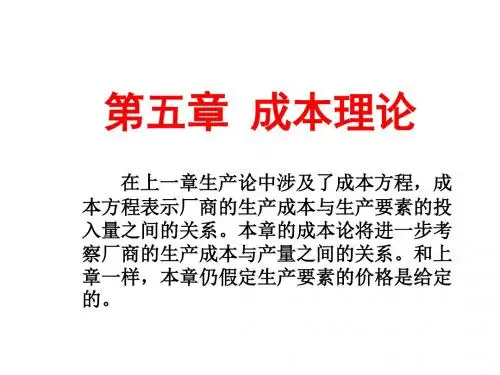

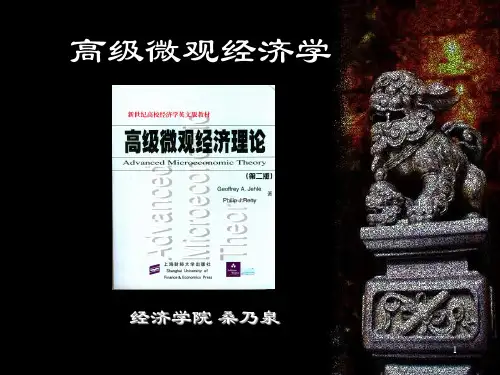
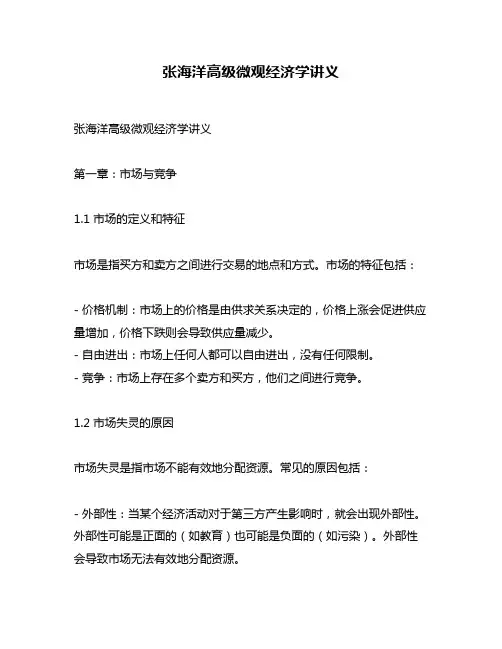
张海洋高级微观经济学讲义张海洋高级微观经济学讲义第一章:市场与竞争1.1 市场的定义和特征市场是指买方和卖方之间进行交易的地点和方式。
市场的特征包括:- 价格机制:市场上的价格是由供求关系决定的,价格上涨会促进供应量增加,价格下跌则会导致供应量减少。
- 自由进出:市场上任何人都可以自由进出,没有任何限制。
- 竞争:市场上存在多个卖方和买方,他们之间进行竞争。
1.2 市场失灵的原因市场失灵是指市场不能有效地分配资源。
常见的原因包括:- 外部性:当某个经济活动对于第三方产生影响时,就会出现外部性。
外部性可能是正面的(如教育)也可能是负面的(如污染)。
外部性会导致市场无法有效地分配资源。
- 公共物品:公共物品指不排除任何人使用、使用一个人不减少其他人使用量、使用者不需要付费等特征的物品。
公共物品容易出现免费骑车问题(free-rider problem),即有些人不付费却享受了公共物品的好处,导致市场无法提供足够的公共物品。
- 垄断:垄断是指市场上只有一个卖方或买方,他们可以控制价格和数量。
垄断会导致市场无法有效地分配资源。
第二章:消费者理论2.1 边际效用边际效用是指增加一单位消费量所带来的额外效用。
边际效用递减是指随着消费量增加,额外效用逐渐减少。
2.2 消费者最大化效用的条件消费者最大化效用的条件包括:- 边际效用相等原则:当两种商品的边际效用相等时,消费者达到了最优选择。
- 预算约束:消费者所能购买的商品数量受到收入和商品价格的限制。
- 无差异曲线:无差异曲线表示不同组合下产生相同总体效用的点。
在预算约束下,最大化效用意味着在无差异曲线上选择预算约束线上的点。
2.3 替代品和互补品替代品是指能够满足同样需求的不同商品。
互补品是指需要同时使用才能满足需求的商品。
第三章:生产者理论3.1 生产函数生产函数是指将输入转化为输出的关系。
生产函数可以表示为:Q = f(K,L)其中,Q表示输出量,K表示资本量,L表示劳动力。
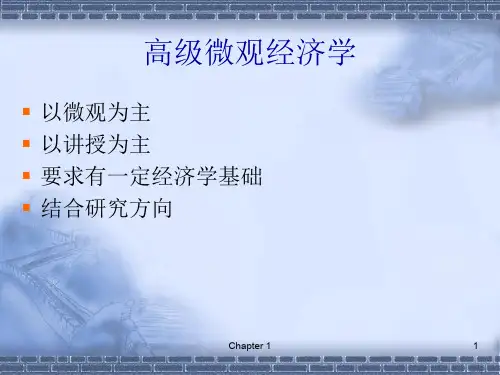
Microeconomic Theory: Lecturer. J. Ping FeiLecture 05- 1Lecture 05 Optimization and Firms IV: Cost FunctionThe cost function c(w, y)= wx (w, y) measures the minimum cost of producing a givenlevel of output for some fixed factor prices. As such it summarizes information about the technological choices available to the firms. It turns out that the behavior of the cost function can tell us a lot about the nature of the firm’s technology.If we have the economic data we can recover things like the demand function for factors of production for the firm just by taking derivatives of costs functions with respect to prices.These cost functions in general will have a particular shape, namely they will be concave. This is equivalent to just thinking about the value of information. This is equivalent to saying that the ability to make decisions when we know the realization of a random variable is more valuable than having to make our decision based simply on the distribution from which that random variable is chosen. And that observation is equivalent to saying that these cost functions must be concave in prices regardless of the shape of the underlying technology or isoquant.The objective here is to get you to learn how to describe the technology of a firm. The most common way in intermediate course is production function. In this lecture, we will discuss some economically relevant aspects of a firm’ technology.1. Total cost ,average cost and marginal cost.We will graph cost as a function of output and hold the factor prices constant. It is understood that factor prices are included but they will not be changing. Let’s start with asimple case. Suppose that the only factor of production that is variable is labor and that there is a fixed cost. First, let’s draw a graph for the isoquants. See figure 1.wL+ fixed costKTotal costFCLqFigure 1Figure 2In the short run we will fix the amount of capital. The only way the firm can vary theamount of output it produces is to vary the labor that it hires. Under some reasonableconditions such as constant return to scale (to both variable and fixed factors), the isoquantswill be getting further apart. In other words, each time I have to hire more and more labor toproduce one more unit of output while holding K fixed. If I produce no output at all, I stillhave to pay the cost associated with the fixed amount of capital. As I start producing someoutput, my cost increases. (My total cost in this case is wages times the amount of labor plusthe fixed cost). Initially, my cost increases slowly but later I have to hire more and more laborto produce an additional unit of output, so my cost increases at an increasing rate as shown infigure 2.We can now define two notions: total cost and average cost. Total cost is shown infigure 2. Average cost is total cost divided by the units of output produced, or TC/q. In1Microeconomic Theory: Lecturer. J. Ping FeiLecture 05- 2terms of figure 2, average cost is the slope of the ray from the origin to the total cost curve.This would be the slope of the diagonal lines in Figure 2. When output is close to zero,average cost is really big (the slope is really steep). If my total cost is $10,000 and I produceone unit of output, my average cost is $10,000. If I only produce 1/2 unit of output, my average cost is $20,000, assuming the variable cost of ½ unit and 1 unit are the same. Asoutput increases, the slope decreases until it reaches a minimum. Beyond that minimum,average cost starts to rise again. So, my average cost curve might be expected to have somekind of a U-shape (see figure 3).Marginal cost. Marginal cost is the cost of producing one more unit of output. Marginalcost is the derivative of total cost with respect to output (q). As output increases, the slope ofmarginal cost gets steeper. Since capital is fixed (say capital is the amount of machines Ihave), the only way I can increase my output is by hiring more unit of labor. However, themore people I hire to work with the same number of machines, the less additional output Iwill be getting from each additional unit of labor. Eventually, I will run into some capacitylimitation and my output will be very difficult to increase.MCACTotal cost for the small factoryTotal cost for the large factoryqFigure 3Figure 4The marginal cost curve goes through the minimum of the average cost curve (see figure 3)because the minimum average cost is where the average cost is tangent to total cost (seefigure 2), and the slope of the tangent to total cost is marginal cost.For the intuition, think about bowling scores. You know that if you score less than youraverage, then you lower your average and if you score more than your average, then you raiseyou average. If your average stays the same, it must be because your score on the last gamewas the same as your average.Long run total cost and short run total cost. In the long run I can choose the amount ofthe fixed input, capital in this case. For example, I can choose between a small factory and alarge one. In terms of the graph, the total cost curve of a small factory will have a lower levelof fixed cost than the large factory. However, the total cost curve of the small factory willrise faster than the total cost curve of the larger factory (see figure 4).Which factory would I rather have? It would depend on how much I want to produce. IfI want to produce any amount up to where the short run total cost curves intersect, I wouldrather have the smaller factory because it produces it more cheaply. On the other hand, if Iwant to produce a large amount of output, then I want to have the larger factory because itproduces that level of output at a lower cost. If these two factories are my only alternatives,in the long run my total cost curve would look like the thick line in figure 4.If we have more alternatives in terms of size of factories (each alternative has a differenttotal cost curve), in the long run the cost of any particular level of output is going to be thecost associated with the cheapest means of producing that level of output. The long run totalcost curve will be the lower bound of all the short run total cost curves (see figure 5).2Microeconomic Theory: Lecturer. J. Ping FeiLecture 05- 3SRTCSRTC (1) SRTC LRTCAC (1)AC (3) AC (2)LRACqq11Figure 5Figure 6The LRTC curve is just the lower ‘envelope’ of all the SRTC curves. The LRTC curvedoes not have to start at the origin if there are fixed costs. For any particular set of fixedfactors, short run total cost is the minimum total cost over all of the factors that are variable.Long run total cost for a given level of output is the minimum of short run total cost overfixed factors of production given the level of output. And this is equal to the minimum (overfixed factors) of the minimum (over variable factors) of total cost given q.The question is in what order we are doing the minimization. We turned this into atwo-stage problem. My costs depend not only on the level of output but also on how much ofthe variable factors I hire and how much of the fixed factors I hire. We are defining short runcost as what you get when you minimize over the variable factors. And we are defining longrun cost as what you get when you minimize the short run cost over the fixed factor. What weend up with is a long run total cost obtained by minimizing costs over both fixed and variablefactors. The order of the minimization does not matter.Long run average cost and short run average cost. Figure 6 shows the average costcurves corresponding to the total cost curves in figure 5.short-run total cost=STC=wv xv (w, y, xf ) + wf x fshort-run average cost=SAC=c(w, y, xf ) / yshort-run average variable cost=SAVC=wv xv (w, y, xf ) / yshort-run average fixed cost=SAFC=wf x f / yshort-run marginal cost=SMC=∂c(w, y, x f ) / ∂ylong-run average cost=LAC=c(w, y) / ∂ylong-run marginal cost=LMC=∂c(w, y) / ∂yTo derive the long run and short run average cost curves, suppose we choose a certain level of output, say q1. At output level q1, long run total cost was obtained by choosing the minimum of all ways of producing q1. Output level q1 was produced at lowest cost by factory 1. At q1, the average total costs are the same in the short run and the long run. If factory 1 produces at any level of output different from q1, short run total costs are higher than long run total costs, and hence short run average costs are higher than long run average costs.We can repeat this analysis with factories 2 and 3. So the long run average cost curve is the envelope of the short run average cost curves, in the same way that my long run cost curve is the envelope of the short run total cost curves. Also, long run and short run average costs will be the same for the output level for which the particular factory is the least costly at producing the given level of output.3Microeconomic Theory: Lecturer. J. Ping FeiLecture 05- 4Note that the place where the SRAC curves and the LRAC curve are tangent is notnecessarily the minimum of each SRAC curve. When the LRAC curve is declining thetangency point occurs before the minimum of the SRAC curve and where the LRAC curve isincreasing, the tangency point occurs beyond the minimum of the SRAC curve. The onlypoint where the tangency point occurs at the minimum of a SRAC curve is at the minimum ofthe LRAC curve.This may sound confusing because we are saying that to produce a level of output q1, the best plant to use is plant 1. However, q1 is not the best level of output for that particular plant. Plant 1 could produce a higher level of output at a lower average cost. But if we want toproduce at that higher level of output, plant 1 would not be the best plant to use.We are not interested in the level of output that a plant produces most cheaply for itself.Instead, we are interested in how well that plant produces a particular level of output, relativeto other plants.If I want to produce 100 units of output and plant 1 produces the 100 units of output atthe lowest cost, I do not care if plant 1 can produce 110 units at a lower average cost. What Icare about is which plant produces 100 units in the cheapest way.A baseball analogy: I am interested in putting the best second baseman at second base.The fact that he may be a better third baseman does not interest me if I have a guy who playsthird base still better than he. The fact that you do third base best does not interest me if youhappen to be the best second base player I have and if I have a guy who can play third basebetter than you can.To summarize, what is important to you is not running a plant at its minimum averagecost. What is important to you is deciding what level of output you want to produce anddeciding how to produce that level of output in the cheapest way.How do we decide what level of output I want to produce? Suppose I can sell myoutput at price p per unit of output. If I sell q units, my revenue is pq. My profit is my revenueminus my cost. Graphically, my profit is the vertical difference between the revenue line andthe total cost curve (it does not matter if it is short run total cost or long run total cost) (seefigure 7).$TC Revenue (pq)LRMC LRACNegative profitsPPositive profitsqq*q*Figure 7Figure 8If I want to maximize my profit, I have to choose the point where the curves are thefurthest apart, that is, where the slopes are the same. Since the slope of the revenue line is theprice of output, and the slope of the total cost curve is marginal cost, I maximize my profitwhere price equals marginal cost (where output = q* in figure 7). If I produce less than that,price is greater than marginal cost and I can make more money by producing more. If Iproduce at a point where marginal cost is greater than price, then I can make more money byproducing less.4Microeconomic Theory: Lecturer. J. Ping FeiLecture 05- 5In figure 8, I maximize my profit if I produce at the level of output where the LRMC is equal to the price (at q*).So, I want to produce a level of output q*, and I want to produce it in the cheapest way. The factory associated with the SRAC curve in figure 8 is the factory that produces q* in the cheapest way. In this case, q* is at a point beyond the minimum for that factory.2.Examples:1). The short-run Cobb-Douglas cost functions. min w1x1 + w2 x2 s.t. x2 = k and y = x1a x12−a1−a⇒ SAC = w1( y / k) a + w2k / y1−aSMC=w1( y / k) a / a Proposition 1: Constant returns to scale. If the production function exhibits constant returns to scale, the cost function may be written as c(w, y)= y c(w,1).Proof: let x* be a cheapest way to produce one unit of output at prices w. Notice that yx* is feasible to produce y since the technology is constant returns to scale. Suppose it does not minimize cost; instead let x′ be the cost-minimizing bundle to produce y at w so wx′/y<wyx*/y. Then x′/y can produce 1 since the technology is constant returns to scale.Proposition 2: Marginal costs equal average costs at the point of minimum average costs.Proof: Let y* denote the point of minimum average cost, then to the left of y* averagecosts are declining so that for y≤y* d (c( y) / y) / dy ≤ 0 which implies c′( y) ≤ c( y) / y ∀y ≤ y * . A similar analysis shows that c′( y) ≥ c( y) / y ∀y ≥ y * .Proposition 3:limy→0cv( y) y= cv′ (0)2). CD cost curves1c( y) = Ky a+b1− a −bAC( y) = Ky a+bMC( y) = c′( y) =K1−a −by a+ba+bProposition 4: The long- and short run (average) cost curves are tangent.3. Factor prices and cost functionsProperties of the cost function (1) Non-decreasing in prices. If w′≥w, then c(w′, y) ≥c(w, y). (2) Homogeneous of degree 1 in w. c(tw, y)= t c(w, y) for t>0. (3) Concave in w. c(tw + (1− t)w′, y) ≥ tc(w, y) + (1− t)c(w′, y) ∀0 ≤ t ≤ 1(4) Continuous in w. c(w, y) is continuous as a function of w for w ? 0. (5) Shephard’s lemma. (the derivative property.) Let xi(w, y)be the firm’s conditional factor demand for input i. Then if the cost function is differentiable at (w, y), and wi>0 for i=1, …, n,5Microeconomic Theory: Lecturer. J. Ping FeiLecture 05- 6then xi (w, y) = ∂c(w, y) / ∂wi i = 1,L, n . Proof: Construct g(w)= c(w, y)−wx*, since is thecheapest way to produce y, ∂g(w)/∂wi=0. We can also prove it by the definition of c(w, y)= wx(w, y) or directly by the envelopetheorem. The concavity of the cost function is also a nice geometrical argument.4. The envelope theorem for constrained optimizationdM (a) = ∂L(x, a)da∂ax= x(a )=∂g ∂ax=x(a)−λ∂h ∂aApplications: Shephard’s lemma⇒∂c(w, ∂wiy)=xixi = xi ( w, y )=xi (w,y),marginal cost L = w1x1 + w2 x2 − λ[ f (x1, x2 ) − y] ∂c(w1, w2 , y) / ∂y = λ5. Comparative statics using the cost function1) The cost function is nondecreasing in factor prices⇔ Factor demand x(w,y) is nonnegative. 2) The cost function is homogeneous of degree 1 in w ⇔ x(w,y) is homogeneous of degree 0. 3) The cost function is concave in w has the following implications.a) the cross-price effects are symmetric. b) the own-price effects are nonpositive. c) dwdx≤06。